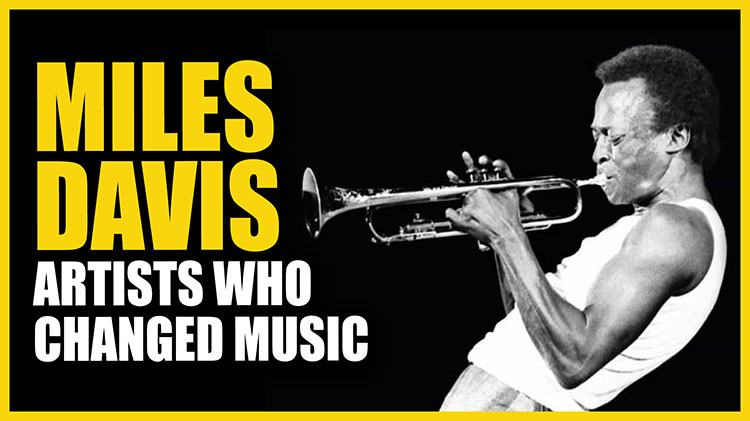Miles Davis was one of the most important musical and cultural icons of the 20th century. He was a jazz trumpeter, bandleader, and composer, and was the biggest star in jazz for almost half a century. In addition to his musical influence, Davis was also extremely charismatic and a style icon.
Miles Dewey Davis was born on May 26, 1926, in Alton Illinois, and raised in East St. Louis. Davis received his first trumpet at age 9, and took lessons from “the biggest influence on my life,” Elwood Buchanan, a teacher and musician who was a patient of his father. In his lessons, Buchanan stressed the importance that Davis play without vibrato, and use a clear, mid-range tone, which was against the style of that time. By age 12, music was the most important thing in Davis’s life, and at 13 he began to play in local bands.
In 1944, Davis moved to New York to study at the Julliard School of Music. However, his true learning ground quickly became 52nd Street – often simply called “The Street” – where all the jazz clubs were located. It was here that he met saxophonist Charlie Parker and trumpeter Dizzy Gillespie, the two leading stars of the bebop genre.
In 1945, Davis dropped out of Julliard, choosing instead to pursue performing full-time. He began performing at clubs on 52nd Street with Coleman Hawkins and Eddie “Lockjaw” Davis. In April of 1945, Davis had his first recording session, when he entered the studio as a sideman for Herbie Fields’s band.
Later that year, he became a sideman to Charlie Parker and immediately set himself apart by not only playing a different trumpet sound, but also avoiding the virtuoso, super fast playing that was the hallmark of bebop soloists at the time.
Davis’s aversion to this style sowed the seeds for one of the aspects of his soloing style that he became famous for. His ability to convey more feeling by playing less, by leaving spaces. He later explained, “I always listen for what I can leave out.”
Davis enjoyed his first recording session at leader in 1947, and in 1949, when he was still only 23, he created his first epoch making recording: The Birth of the Cool. Though the album wouldn’t be released until 1957, these tunes introduced the concept of “cool” to the jazz world, dominated by the frenetic bebop. The album was based on orchestral style arrangements, in part by Gil Evans, a composer and arranger. This album remains one of the most influential jazz albums of all time.
Miles Davis once said, “I have to change, it’s like a curse.” Constant change was at the heart of Davis’s music, and as a result, he was at the forefront of several new musical genres. For him, regurgitating old hits was creative death. Normally, innovative artists are celebrated if they manage to change the course of music once, but astonishingly, Davis was at the forefront of cool jazz in 1949-1950, hard bop in the mid 1950s, modal jazz and orchestral jazz in the late 1950s, avant bop in the mid 1960s, and jazz rock in the late 1960s through the 1980s. Because of these constant stylistic changes, Davis is often likened to Picasso.
Several of Davis’s albums are credited with changing the course of music, but two that stand out most are Kind of Blue and Bitches Brew.
Kind of Blue was released in 1959, during his modal jazz period, and is widely regarded as the greatest jazz album of all time. Released in August 1959, Kind of Blue was an instant success, with widespread radio airplay and rave reviews from critics. It remains the best selling jazz album of all time.
Bitches Brew, released in 1970, was both influential and controversial. The album has been called the Big Bang of jazz rock, as it mixed jazz with not only rock, but also psychedelic, folk, and world music, as well as advanced studio production techniques. This album greatly upset jazz purists. This was at least partially because it was popular at a time when jazz was in decline. Like many of his colleagues in the mid 1960s, Davis was playing to just a few dozen jazz fans in clubs, but as a result of the crossover success of Bitches Brew, he played to more than half a million people at the Isle of Wight Festival in 1970. Jazz purists accused Davis of selling out, but his pioneering jazz-rock experiments influenced several generations of jazz, rock, folk, electronic, and hip hop musicians.
Davis was also an amazing talent spotter, and enlisted tons of unknown and up-and-coming musicians to play in his band, many of whom went on to have amazing careers of their own. The list is incredibly long, but includes John Coltrane, Herbie Hancock, Tony Williams, Chick Corea, Dave Holland, John McLaughlin, and many, many more. He was an expert at developing these musicians, and made his band members play better than they ever had before. According to John McLaughlin, “Miles has the capacity to draw out of people things that even surprise the musicians themselves. He’s been a guru of sorts to a lot of people.” His musicians called him a magician, zen teacher, guru, sorcerer, and teacher. Dave Holland said, ” He had the best understanding of time, space, and movement if anybody I have ever worked with.”
Finally, as if everything else he had accomplished and all the times he had changed the course of music weren’t enough, Davis’s keen dress sense, good looks, and larger-than-life charisma turned him into a style icon. Miles Davis was one of the biggest stars in music, and a household name for the last 10 years of his life.
